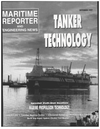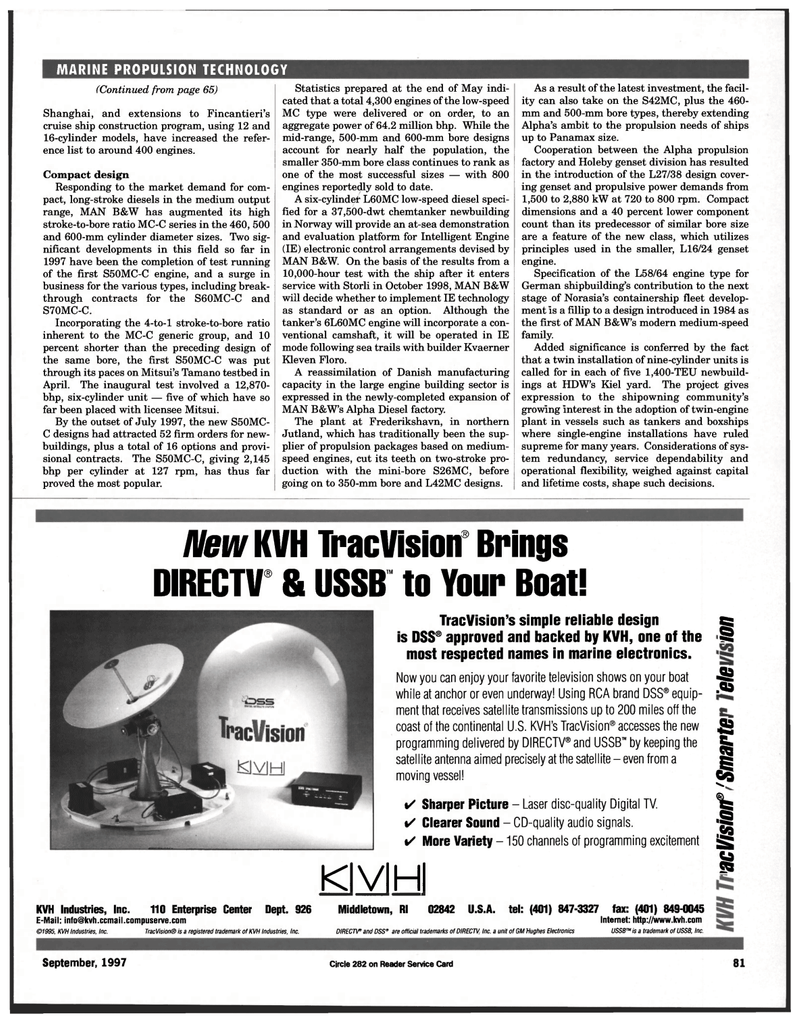
Page 81: of Maritime Reporter Magazine (September 1997)
Read this page in Pdf, Flash or Html5 edition of September 1997 Maritime Reporter Magazine
MARINE PROPULSION TECHNOLOGY (Continued from page 65)
Shanghai, and extensions to Fincantieri's cruise ship construction program, using 12 and 16-cylinder models, have increased the refer- ence list to around 400 engines.
Compact design
Responding to the market demand for com- pact, long-stroke diesels in the medium output range, MAN B&W has augmented its high stroke-to-bore ratio MC-C series in the 460, 500 and 600-mm cylinder diameter sizes. Two sig- nificant developments in this field so far in 1997 have been the completion of test running of the first S50MC-C engine, and a surge in business for the various types, including break- through contracts for the S60MC-C and
S70MC-C.
Incorporating the 4-to-l stroke-to-bore ratio inherent to the MC-C generic group, and 10 percent shorter than the preceding design of the same bore, the first S50MC-C was put through its paces on Mitsui's Tamano testbed in
April. The inaugural test involved a 12,870- bhp, six-cylinder unit — five of which have so far been placed with licensee Mitsui.
By the outset of July 1997, the new S50MC-
C designs had attracted 52 firm orders for new- buildings, plus a total of 16 options and provi- sional contracts. The S50MC-C, giving 2,145 bhp per cylinder at 127 rpm, has thus far proved the most popular.
Statistics prepared at the end of May indi- cated that a total 4,300 engines of the low-speed
MC type were delivered or on order, to an aggregate power of 64.2 million bhp. While the mid-range, 500-mm and 600-mm bore designs account for nearly half the population, the smaller 350-mm bore class continues to rank as one of the most successful sizes — with 800 engines reportedly sold to date.
A six-cylindeT L60MC low-speed diesel speci- fied for a 37,500-dwt chemtanker newbuilding in Norway will provide an at-sea demonstration and evaluation platform for Intelligent Engine (IE) electronic control arrangements devised by
MAN B&W. On the basis of the results from a 10,000-hour test with the ship after it enters service with Storli in October 1998, MAN B&W will decide whether to implement IE technology as standard or as an option. Although the tanker's 6L60MC engine will incorporate a con- ventional camshaft, it will be operated in IE mode following sea trails with builder Kvaerner
Kleven Floro.
A reassimilation of Danish manufacturing capacity in the large engine building sector is expressed in the newly-completed expansion of
MAN B&W's Alpha Diesel factory.
The plant at Frederikshavn, in northern
Jutland, which has traditionally been the sup- plier of propulsion packages based on medium- speed engines, cut its teeth on two-stroke pro- duction with the mini-bore S26MC, before going on to 350-mm bore and L42MC designs.
As a result of the latest investment, the facil- ity can also take on the S42MC, plus the 460- mm and 500-mm bore types, thereby extending
Alpha's ambit to the propulsion needs of ships up to Panamax size.
Cooperation between the Alpha propulsion factory and Holeby genset division has resulted in the introduction of the L27/38 design cover- ing genset and propulsive power demands from 1,500 to 2,880 kW at 720 to 800 rpm. Compact dimensions and a 40 percent lower component count than its predecessor of similar bore size are a feature of the new class, which utilizes principles used in the smaller, L16/24 genset engine.
Specification of the L58/64 engine type for
German shipbuilding's contribution to the next stage of Norasia's containership fleet develop- ment is a fillip to a design introduced in 1984 as the first of MAN B&W's modern medium-speed family.
Added significance is conferred by the fact that a twin installation of nine-cylinder units is called for in each of five 1,400-TEU newbuild- ings at HDW's Kiel yard. The project gives expression to the shipowning community's growing interest in the adoption of twin-engine plant in vessels such as tankers and boxships where single-engine installations have ruled supreme for many years. Considerations of sys- tem redundancy, service dependability and operational flexibility, weighed against capital and lifetime costs, shape such decisions. /Ilew KVH TracVision Brings
DIRECTV & USSB to Your Boat! i •82 .03 £2 i S» 1 •sa 1
KVH Industries, Inc. 110 Enterprise Center Dept. 926 Middletown, Rl 02842 U.S.A. tel: (401) 847-3327 fax: (401) 849-0045
E-Mail: [email protected] Internet: http://www.kvh.com ©1995, KVH Industries, Inc. TracVision® is a registered trademark of KVH Industries, Inc. DIRECTV and DSS° are official trademarks of DIRECTV, Inc. a unit of GM Hughes Electronics USSB™ is a trademark of USSB, Inc.
TracVision's simple reliable design is DSS@ approved and backed by KVH, one of the most respected names in marine electronics.
Now you can enjoy your favorite television shows on your boat while at anchor or even underway! Using RCA brand DSS® equip- ment that receives satellite transmissions up to 200 miles off the coast of the continental U.S. KVH's TracVision® accesses the new programming delivered by DIRECTV® and USSB™ by keeping the satellite antenna aimed precisely at the satellite - even from a moving vessel! • Sharper Picture - Laser disc-quality Digital TV. • Clearer Sound - CD-quality audio signals. • More Variety -150 channels of programming excitement
KIYIHI
September, 1997 Circle 282 on Reader Service Card 81

 80
80

 82
82
